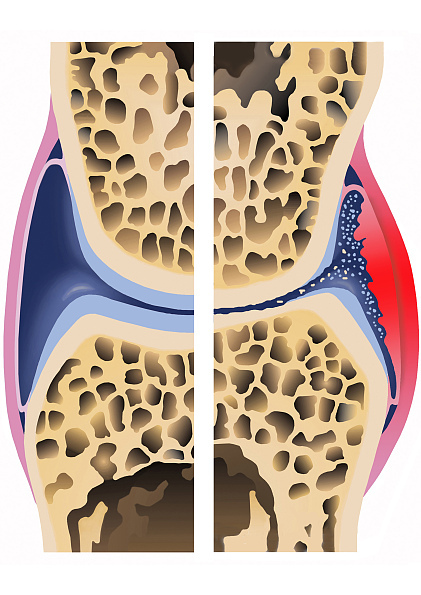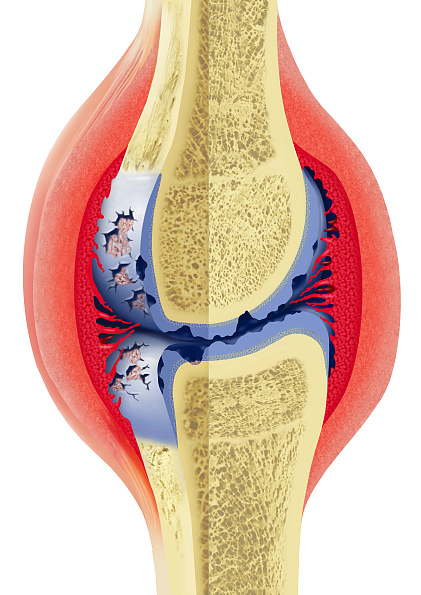Joints
Effects of Bioactive Collagen Peptides on Joints
Articular cartilage is particularly important for joint mobility and health. Damage of cartilage and tendons by overload, injury, or aging leads to inflammation and faulty loading, which finally results in the degeneration of joint tissue. The underlying disease is referred to as osteoarthritis and affects both the cartilage and the bone.
In healthy individuals, a dynamic balance is maintained between formation and degradation of extracellular matrix components such as collagen type II and aggrecan by cartilage cells (chondrocytes).
This balance is disturbed in favor of degradation in many joint diseases [Lee et al. 2013]. Bioactive Collagen Peptides (e.g. Collagile pet) are able to shift the imbalance back to anabolic metabolism. They provide amino acids like glycine, proline, and hydroxyproline, which are important for collagen formation, and they stimulate collagen and extracellular matrix synthesis by chondrocytes [Bello et al. 2006].
Clinical Studies in Dogs
In 2004, Weide published an observational study following 30 dogs who were given 20 g Bioactive Collagen Peptides (e.g. Collagile pet) with their food every day for 16 weeks. Of those dogs, 20 had chronic diseases of the musculoskeletal system (osteoarthritis or joint dysplasia) and the remaining 10 dogs, who were clinically healthy with respect to orthopedics, were used as a control. After the 16-week test period, the authors found significantly decreased lameness levels in the dogs with chronic diseases. The study included shepherd dogs or breeds of comparable size with a body weight of 26 to 46 kg (57 to 102 lbs) and an average weight of 36.75 kg (81.02 lbs). The average age of the ill dogs and the control dogs was 7.2 years and 2.5 years, respectively. At the beginning and end of the treatment, the degree of lameness was recorded and compared according to a standardized system (according to Brunnberg). According to the dog owner’s reports, the dogs showed an increased joy of running and fewer problems when getting up and when walking up or down the stairs.
Both at the beginning and the end of the study, blood samples were taken from all of the dogs and tested for specific biomarkers of joint metabolism. The results showed that a reduced lameness was accompanied by a decrease in MMP-3 (matrix metalloprotease 3, a biomarker of cartilage degradation) and an increase in TIMP-1 (tissue inhibitor of metalloprotease 1, a biomarker and inhibitor of cartilage degeneration). The fact that these molecular changes were also found in supplemented healthy dogs suggests that collagen peptides may protect healthy dogs from joint degeneration as well.
In 2006, Hesse conducted an observational study with 26 older dogs (average age 8.2 years) who had been suffering from chronic lameness of the hind legs for at least one year. Every day for 8 weeks, the dogs received 20 g Bioactive Collagen Peptides (e.g. Collagile pet) together with their food. Parameters such as the lameness according to Brunnberg’s standardization system, the severity of osteoarthritis in x-rays, and the circumference of thigh muscles were recorded by a veterinarian at baseline of the study, after 4 weeks, and at the end of the study. In addition, the dog owners had to assess the health and disease levels according to a standardized protocol based on the Lequesne Index.
12 out of 20 dogs who completed the study had hip dysplasia (HD) grade B or worse, 2 dogs had HD grade C and also suffered from a former cauda equina syndrome (CES), 3 dogs suffered from knee osteoarthritis due to former cruciate ligament rupture, and 3 dogs suffered from spondylarthrosis of the lumbar spine. Six dogs were excluded from the study for various reasons, but none of those cases were related to Bioactive Collagen Peptide (e.g. Collagile pet) treatment.
At the end of the study, a clear improvement of lameness levels was found, especially in the severely ill dogs. The assessment by the dog owners revealed an improvement in all areas of activity, although no statistical significance was reached. The study also demonstrated no effect on dogs with spondylarthrosis or long-term cauda equina syndrome.
In 2017, a specific collagen hydrolysate with Bioactive Collagen Peptides (e.g. Collagile pet) was investigated to show the effect on cartilage metabolism in cell culture as well as in vivo in 22 dogs suffering from treatment-resistant osteoarthritis [Schunk et al. 2017]. Cell culture experiments showed that chondrocyte synthesis of collagen type II, aggrecan; and elastin increase after 2 to 3 weeks (7.5%, 5.5%, and 6.3%, respectively), whereas inflammatory cytokines and degenerative proteases decrease in a statistically significant way. According to the authors, there was a clear correlation between the effects in vitro and the improved symptoms in dogs after 12 weeks of treatment. As a complete data evaluation was only given for three of the dogs, the study shows significant limitations.
The results will be tested in a placebo-controlled clinical trial which has not yet been completed.
Clinical Studies in Horses
The effect of Bioactive Collagen Peptides (e.g. Collagile pet) in horses with mild to moderate osteoarthritis was tested in a study at two centers. Horses of different breeds and ages were administered either 25 g (16 horses) or 50 g (12 horses) Bioactive Collagen Peptides (e.g. Collagile pet), or 25 g placebo (10 horses) daily for 12 weeks. The following parameters were evaluated: gait pattern, lameness, step pattern, step length, arch of flight, pain symptoms during joint flexion or rotation, as well as the horse owners’ opinion collected on the basis of a standardized questionnaire. After a 12-weeks period, the highest dose of Bioactive Collagen Peptides had resulted in the best overall effect. The authors therefore recommend a dosage of 50 g Bioactive Collagen Peptides (e.g. Collagile pet) for horses with a body weight between 350 and 550 kg (770 – 1200 lbs) [Dobenecker et al. 2018]. The horses with the 25 g daily dose also showed some improvement compared to the placebo group, although the effect was less pronounced. Despite some limitations of the study (e.g., no double-blind study design), the results support the efficacy of Bioactive Collagen Peptides (e.g. Collagile pet).
Clinical Studies in Humans
In 2011, McAlindon and colleagues published a placebo-controlled pilot study with 30 patients suffering from mild knee osteoarthritis. The proteoglycan content of cartilage in patients treated with 10 g collagen hydrolysate was increased as compared to that of patients in the placebo group. This increase was statistically significant after 24 weeks, but was no longer found after 48 weeks [McAlindon et al. 2011]. The study provides evidence of a positive effect of Bioactive Collagen Peptides (e.g. Collagile pet) despite the fact that only a small number of volunteers was included and the increase in proteoglycans was not stable over a longer period of time.
Systematic reviews comparing the results of several studies could be more informative about the efficacy of collagen peptide treatment.
A review by Liu et al. compared the impact of collagen hydrolysates and found a statistically significant effect on pain lasting for at least three months [Liu et al. 2017]. Overall, data on the efficacy of collagen hydrolysates in joint diseases is sparse, and large and long-term controlled studies are still required [Liu et al. 2017]. The effect on different subgroups (specific causes of disease, different characteristics and joint types) also has to be evaluated in further studies. It could also be useful to have precise information on specific preparation steps, as this might significantly affect the efficacy of different products.
Further studies will be presented here soon.
Illustrative Material

Healthy and Arthrotic Joints (Osteoarthritis)
Schematic view of healthy joint (left) and arthrotic joint (right)
Osteoarthritis (degenerative joint disease) is the most common disease of a joint. Joint degeneration can result from joint wear and tear (arthrosis deformans).
The cause of primary osteoarthrosis is not yet clear, but a poor quality of cartilage tissue seems to be involved. Secondary osteoarthrosis results from mechanical overuse of a joint (e.g., in hip dysplasia), inflammatory reactions (in osteoarthritis), or metabolic disorders (in chondrocalcinosis).
Cartilage abrasion can be gradual (latent osteoarthritis) or turn into a very painful disease (activated osteoarthritis). Although the degradation of cartilage tissue cannot be stopped by the work of physicians, the progression of the disease can at least be slowed down.

Joints in Rheumatoid Arthritis (Chronic Polyarthritis)
Schematic view of a joint affected by active rheumatoid arthritis. Rheumatoid arthritis (chronic polyarthritis) refers to an autoimmune disease that results in tissue destruction induces by the body’s own immune reactions.
Inflammatory defense reactions are characterized by classic features such as heat, redness, swelling with restricted movement (functio laesia), and pain. The invasion of misdirected (autoreactive) immune cells plays an important role in disease progression, resulting in inflammation of the joint (osteoarthritis), cartilage destruction, and over-activation of bone-degrading cells (osteoclasts).
Both sides of the joint are affected in most cases and there is a preference for small joints. Further characteristics are nocturnal pain, morning stiffness, and disease progression highly refractory to standard therapy.
Source of figure: Frank Geisler (MediDesign)
Last update: October 2022